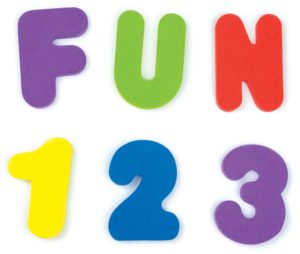So, your child has entered school, and you have been told that your child is reading at a Level “A,” or “D,”…maybe your 4th-grader is now at a Level “34,” or is effectively a “3.5 Independent.” What do all these numbers, letters, and labels mean anyway?
Reading Levels are letter and number tools assigned to literature of varying degrees of difficulty. The reason for leveling is to facilitate selection of appropriate reading material for your child, both in and out of the classroom. Within the classroom, Reading Levels are used in the creation of Guided Reading Groups, where children are homogeneously grouped for decoding, comprehension and other reading strategy-based groups. They are also used to help children and teacher select appropriate independent reading material for students during Readers Workshop.
Leveling a book provides teachers with the tool to remove the “one size fits all” approach to literacy. In practice, each child is able to choose a “Just Right” book, commensurate with his reading ability, both fluency-wise as well as comprehension-wise. Using various assessments, teachers will determine how well your child is reading, and will match him to books that are, as educators put it, “at the zone of proximal development,”- in lay-terms, neither too easy, nor too difficult. Books are labeled by levels of difficulty, and children are generally assessed at the beginning of the school year and then at the end. Ongoing assessment is done informally, and when discrepancies in ability and performance, or difficulties arise, teachers may assess mid-year, or on an “as-needed” basis (sometimes reading is monitored continually, with a method called “Running Records.” When a level is determined, children are guided to choose books for reading at that level, at which they generally achieve 90% accuracy, and with about 70% comprehension. These are considered Independent Levels. An Instructional Level is generally considered to be one level up, and represents the level at which a child will optimally be taught in class, either in whole-group, or in small-group Guided Reading groups.
There are several systems for book leveling, the most common ones being Fountas and Pinnell, and DRA (Developmental Reading Assessment) Levels. Fountas and Pinnell Levels are letters assigned to grades, more specifically to the specific months of those grades. DRA Levels are numerical scores that correlate to grades, again, specifically month by month of that school year. The letters and numbers are considered Instructional “Benchmarks,” or the level at which students should optimally be receiving instruction at particular points in the school year.
It is important to remember, that even when a parent is given a child’s independent reading level, it is perfectly alright for at-home reading to include books that are below that level. “Acing” a familiar book is a perfect way to maintain and maximize a child’s time with his “eyes on print,” and to encourage his relationship with books. As he reads and rereads books that are easy for him, his confidence as a reader will grow, and he will be more agreeable to trying out books that are more difficult as well. And it must be remembered that books that a parent is actually reading to a child, can, of course, be on any level that the child is able of comprehending, even with parent support and explanation.
As follows is a general Reading Grade-Level Comparison Chart for the 2 most common methods of Book Leveling:
Fountas and Pinnell Level DRA Instructional Benchmark Level
(Grade. Month) (Independent Level is 1 Level Lower)
K.5 A A
K.7 B 2
K.9 C 3
1 C 4
1.2 D 6
1.3 E 8
1.4 F 10
1.5 G 12
1.7 H 14
1.9 I 16
2 J 18
2.3 K 20
2.6 L 24
2.9 M 28
3 N 30
3.5 O 34
3.9 P 38
4 Q *40
4.5 R 40
4.9 S 40
5.0 T **50
5.5 U 50
5.9 V 50
6.0 W 60
6.5 X 60
6.9 Y 60
7.0 Z 70
*At Grade 4 and up, children are expected to enter at the indicated level as Instructional and to leave the Grade at that level as Independent. Guided Reading is generally leveled for the Elementary through Middle School grades. **From Grade 5 and up, the specific Grade and Letter Levels and Numerical Levels begin to overlap, as students’ abilities become more individual and progress at a much less rapid pace than in earlier Elementary years.
Sometimes, when you receive the information about your child’s Reading Level, it may seem that the teacher has assessed your child below the level at which you believe your child should be reading. It is important to remember that reading fluently is not the only measure of a child’s reading ability. Comprehension is key, the “acid test,” if you will. The main reason we read is to get information, either for reference or entertainment; and without comprehension, reading is a moot activity. For this reason, we must not lose sight that our child’s comprehension is the main indicator of his reading level. Sometimes children have slow fluency, yet their comprehension is excellent. In that case the reading level might justifiably be identified as higher than fluency alone might indicate. Conversely, a child may have excellent decoding skills and quick fluency, yet during assessment not demonstrate adequate comprehension (particularly implicit comprehension, which includes the ability to make inferences). A child like this may be given a reading level that seems low, but his comprehension ability must be the deciding factor in determining the appropriate level. Of course, when there is too large a gap between fluency and comprehension, further investigation into underlying causes may be called for, and in certain cases, remedial reading interventions may be indicated in either the area of decoding or comprehension strategies.
The Rabbi Arthur Schneier Park East Day School is a prestigious NYC Jewish Day School in the heart of New York City. Located in the Upper East Side, this Jewish Day School promotes academic growth through community and collaboration.
